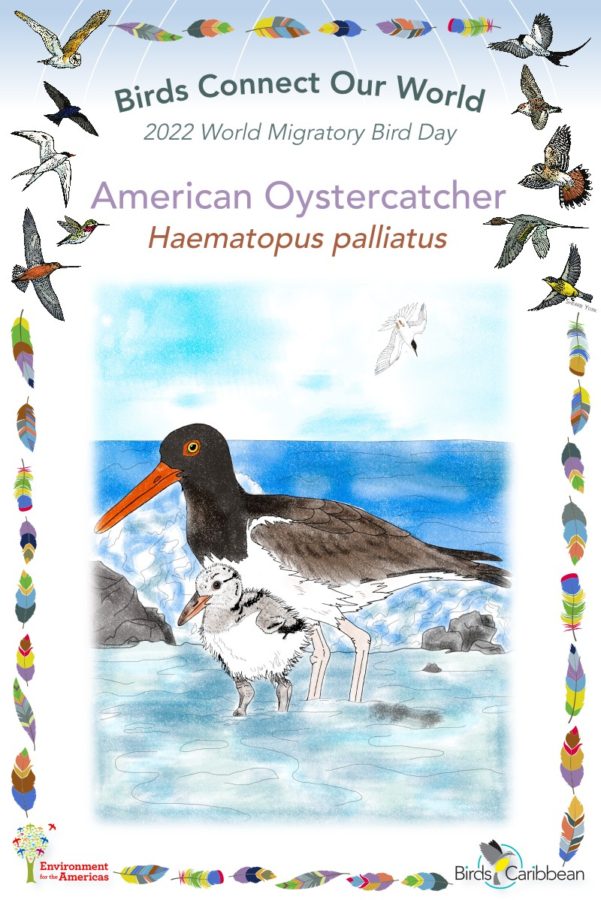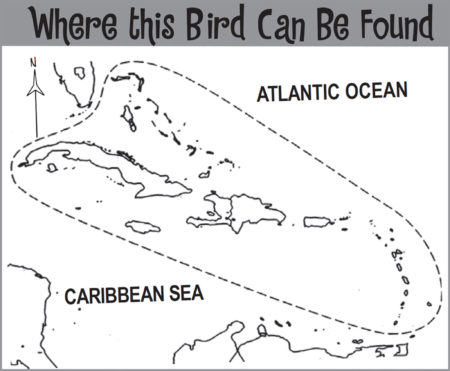Celebrate World Migratory Bird Day (WMBD) with us in 2022! This year’s theme is “Dim The Lights for Birds at Night”. Have fun learning about a new migratory bird every day. We have colouring pages, puzzles, activities, and more. Download for free and enjoy nature with your family at home.
Migratory Bird of the Day: American Oystercatcher
With their large size, striking black and white plumage, pink legs and carrot-like orange bills, American Oystercatchers are truly unmistakable! Males and females look the same, and in addition to their distinctive plumage they have yellow eyes with a red eye ring. If their size and coloring don’t make them conspicuous enough American Oystercatchers will be sure to alert you to their presence with their loud, excited, high-pitched “hueep hueep hueep!” calls.
American Oystercatchers can be found year-round and breed in some islands of the Caribbean, including Cuba, the Bahamas, Virgin Islands, Hispaniola, and some Lesser Antilles islands. Outside of the breeding season they can be found across most of the West Indies, with birds migrating south in Fall from breeding areas on the Atlantic coast of the U.S.
Oystercatchers are true coast-lovers, and can be found in areas of rocky shoreline and on beaches and offshore cays. Their orange bills might look comical but they serve a serious purpose. These shorebirds specialize on feeding on bivalve mollusks. Their bills are powerful with razor-sharp edges for breaking into tightly closed clams, oysters and mussels.
The diet of American Oystercatchers means they are restricted to coastal areas. Although they are not currently considered to be of conservation concern by the IUCN, they are on the Partners in Flight’s Yellow Watch List. This is because their population size was estimated at only 10,000 birds in 2000. This led to a flurry of research on the species and conservation actions by the “American Oystercatcher Working Group.”
Biologists learned that American Oystercatchers are threatened by direct loss of their breeding habitat from coastal development and the impacts of human disturbance. They are less likely to breed successfully on beaches with high levels of human activity. Management actions such as raising public awareness and protecting breeding sites from disturbance are helping the population to recover. Undisturbed coastal areas are vital to help them thrive throughout the year in the Caribbean too. Learn more about this species, including its range, photos, and calls here.
Colour in the American Oystercatcher
Download the Migratory Birds of the Day Colouring Page! Use the picture above and the photos on this page as your guide, or you can look up pictures of the bird online or in a bird field guide if you have one. Share your coloured-in page with us by posting it online and tagging us @BirdsCaribbean #WMBD2022Carib
Listen to the calls of the American Oystercatcher
American Oystercatchers have loud high-pitched ” hueep” or “weeer” calls, which they can repeat in rapid succession (often with increasing rapidity and volume).
Puzzles of the Day
Click on the images below to do the puzzle. You can make the puzzle as easy or as hard as you like – for example, 6, 8, or 12 pieces for young children, all the way up to 1,024 pieces for those that are up for a challenge!
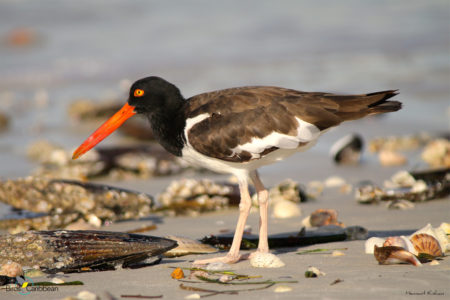
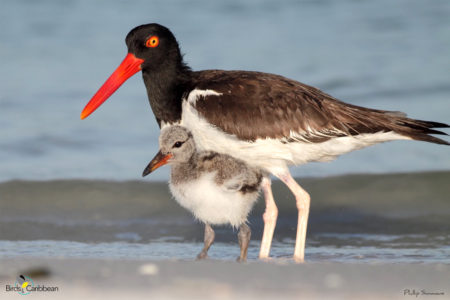
Activity of the Day
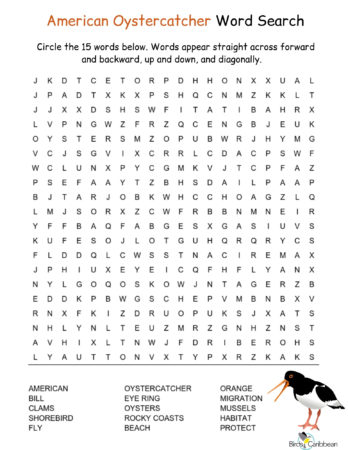 FOR KIDS: Can you find all the words in our American Oystercatcher word search? There are 15 words in total for you to look for. All the words you need to find are linked to the appearance, behaviour, food or favourite habitats of the American Oystercatcher. You can find the answers here.
FOR KIDS: Can you find all the words in our American Oystercatcher word search? There are 15 words in total for you to look for. All the words you need to find are linked to the appearance, behaviour, food or favourite habitats of the American Oystercatcher. You can find the answers here.
FOR KIDS AND ADULTS: Don’t forget that you still have time to take part in this year’s Global Shorebird Count. This takes place between September 1 – 7! To take part all you need to do is visit your local wetland and count all the shorebirds (and other birds) that you see there. Then share your eBird Caribbean list with ‘worldshorebirdsday’. You can find out more about how to take part in our handy blog post. This is full of tips and hints for carrying out a successful survey, including links to help out with shorebird ID.
Enjoy this video of an American Oystercatcher. In the video you can see it using it’s bill as it forages on the rocky shore on some tasty mollusks!

